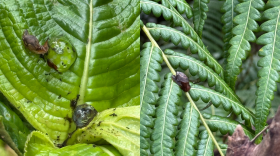A new project at the Bernice Pauahi Bishop Museum may help researchers find Pacific island land snails thought to be extinct.
The Bishop Museum received a $1.3 million grant from the National Science Foundation to digitize its land snail specimen collection by photographing the snail shells and scanning field notes, genetic information, and other material so the data can be easily shared with other researchers and the public.
The Bishop Musem is the lead in the project, which is a collaboration between the Academy of Natural Sciences at Drexel, Museum of Zoology at the University of Michigan, Harvard Museum of Natural History, Florida Museum of Natural History, Field Museum of Natural History and the University of Hawai‘i.
While there are 3.6 million Pacific island land snail specimens that will be a part of the digitization effort. Kenneth Hayes, a leader of the project and director of Pacific Center for Molecular Biodiversity, explained that the focus will be on "type specimens." Type specimens are the original organism that was first collected and on which the species description is based.
The museum plans to photograph both the snail species’ shells, which are usually used for identification, and the lamellae, a tooth-like body part at the edge of the shell that is also a species identifier.
Hayes explained that as technology has evolved, genetics and snail reproductive anatomy have also become common ways to determine a snail’s species.
The project's main goal is to help accelerate the discovery of new species and rediscover extinct ones by analyzing historical data and existing and extinct snail species.
By studying snails that are extinct, researchers can better understand the levels of genetic diversity that have been lost and what factors affect the snail population's viability.
Hayes gave the example of Lonesome George, a Hawaiian land snail that died earlier this year and was believed to be the last of its kind. Lonesome George’s DNA is stored at the museum and will be part of the digitization project.
“Understanding Lonesome George's species relationship to the rest of the family that he belongs to and the other snails might give us some insights into understanding why those species declined, while other species survived,” Hayes said.
However, Hayes listed DNA and historical analyses as the most important aspects of the project because these would allow researchers to target the areas where the land snails were historically found and better determine where to place resources.
He believes the effort could be used to rediscover land snails believed to be extinct. The museum has used the approach before with success.
Hayes and Norine Yeung, another leader on the project, employed the method on a family of endemic Hawaiian land snails that had 325 different species -- most of which are exinct.
A decade ago, when Hayes and Yeung began studying the family of snails, there were only nine or 10 species alive and the rest were gone. However, by digitizing information and targeting areas where the snails were historically found, they were able to rediscover about 14 species of the land snail family.
“We're facing two great challenges, climate change and biodiversity loss. Those two challenges are inextricably linked,” Hayes said. “The historical information housed in places like the Bishop Museum are really going to be key in understanding how we're going to deal with this . . . so that we can begin developing plans of how to mitigate these impacts."




